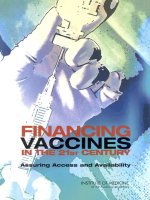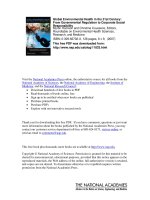UNDERSTANDING HIV/AIDS MANAGEMENT AND CARE – PANDEMIC APPROACHES IN THE 21ST CENTURY potx
Bạn đang xem bản rút gọn của tài liệu. Xem và tải ngay bản đầy đủ của tài liệu tại đây (6.81 MB, 394 trang )
UNDERSTANDING
HIV/AIDS MANAGEMENT
AND CARE – PANDEMIC
APPROACHES
IN THE 21ST CENTURY
Edited by Fyson Hanania Kasenga
Understanding HIV/AIDS Management and Care –
Pandemic Approaches in the 21st Century
Edited by Fyson Hanania Kasenga
Published by InTech
Janeza Trdine 9, 51000 Rijeka, Croatia
Copyright © 2011 InTech
All chapters are Open Access distributed under the Creative Commons Attribution 3.0
license, which allows users to download, copy and build upon published articles even for
commercial purposes, as long as the author and publisher are properly credited, which
ensures maximum dissemination and a wider impact of our publications. After this work
has been published by InTech, authors have the right to republish it, in whole or part, in
any publication of which they are the author, and to make other personal use of the
work. Any republication, referencing or personal use of the work must explicitly identify
the original source.
As for readers, this license allows users to download, copy and build upon published
chapters even for commercial purposes, as long as the author and publisher are properly
credited, which ensures maximum dissemination and a wider impact of our publications.
Notice
Statements and opinions expressed in the chapters are these of the individual contributors
and not necessarily those of the editors or publisher. No responsibility is accepted for the
accuracy of information contained in the published chapters. The publisher assumes no
responsibility for any damage or injury to persons or property arising out of the use of any
materials, instructions, methods or ideas contained in the book.
Publishing Process Manager Alenka Urbancic
Technical Editor Teodora Smiljanic
Cover Designer InTech Design Team
Image Copyright Eraxion, 2011.
First published November, 2011
Printed in Croatia
A free online edition of this book is available at www.intechopen.com
Additional hard copies can be obtained from
Understanding HIV/AIDS Management and Care –
Pandemic Approaches in the 21st Century, Edited by Fyson Hanania Kasenga
p. cm.
ISBN 978-953-307-603-4
free online editions of InTech
Books and Journals can be found at
www.intechopen.com
Contents
Preface IX
Part 1 Prevention of HIV/AIDS in General 1
Chapter 1 HIV Surveillance 3
Ali Mirzazadeh and Saharnaz Nedjat
Chapter 2 Is It Possible to Implement AIDS‘
Prevention in Primary School? 13
Dominique Berger
Chapter 3 Social Determinants
of HIV Health Care: A Tale of Two Cities 33
Rupali Kotwal Doshi, Carlos del Rio and Vincent C. Marconi
Chapter 4 The Role of the Private Sector in HIV and AIDS Interventions
in Developing Countries: The Case of Lesotho 59
Zitha Mokomane and Mokhantšo Makoae
Part 2 Prevention of Mother to Child
Transmission of HIV (PMTCT) 75
Chapter 5 Antenatal Screening
and HIV-Pregnancy: Strategies for Treatment 77
Ali A. Al-Jabri, Abdullah A. Balkhair,
Mohammed S. Al-Balosh and Sidgi S. Hasson
Chapter 6 Effectiveness of the Regular Implementation
of the Mother to Child Transmission Plus
(MTCT-Plus) Program in Burkina Faso, West Africa 87
Fabio Buelli, Virginio Pietra, Richard Fabian Schumacher,
Jacques Simpore, Salvatore Pignatelli, Francesco Castelli
and the ESTHER-Brescia Study Group
Chapter 7 Exosomes Decrease In Vitro Infectivity of HIV-1 Preparations:
Implication for CD4+T Lymphocyte Depletion In Vivo 99
Subra Caroline, Burelout Chantal, Proulx Sophie,
Simard Sébastien and Gilbert Caroline
VI Contents
Chapter 8 Nikavir in Chemoprevention
Regimens of Vertical HIV Transmission 125
Elvira Ivanova, Nadezhda Shmagel and Natalia Vorobeva
Part 3 Understanding Immunological
Aspects of HIV in an Infected Person 149
Chapter 9 Natural Catalytic Antibodies
in Norm and in HIV-Infected Patients 151
Georgy A. Nevinsky
Chapter 10 RNAi-Based Gene Expression Strategies to Combat HIV 193
Fiona T. van den Berg and Marc S. Weinberg
Chapter 11 Exponential Equilibria
and Uniform Boundedness of HIV Infection Model 219
E. Castellanos-Velasco and J. Santos-Ferreira
Part 4 Treatment, Care and Support of HIV/AIDS Patients 237
Chapter 12 Glycosphingolipids in HIV/AIDS:
The Potential Therapeutic Application 239
Clifford A. Lingwood and Donald R. Branch
Chapter 13 Drug-Drug Interactions
as a Challenge in the Treatment of HIV/AIDS 281
Norah L. Katende-Kyenda
Chapter 14 Clinical Relevance of Drug Interactions in
HIV-Infected Patients Receiving Antiretroviral Therapy 301
Pedro Amariles, Newar Giraldo Alzate and Maria Jose Faus
Chapter 15 Acute Kidney Injury in Hospitalized HIV-Infected
Patients in the HAART Era: An Epidemiological View 359
José António Lopes and Sofia Jorge
Chapter 16 Exploring the Nanotechnology-Based
Drug Delivery Systems for AIDS Treatment 367
Flávia Chiva Carvalho, Rubiana Mara Mainardes
and Maria Palmira Daflon Gremião
Preface
This volume, dealing with various aspects of HIV/AIDS, is the outgrowth of a
continuing need for controlling and reducing this pandemic. Scientific approaches
have been used as basis for compiling this book. It should be understood that
HIV/AIDS is a public health problem that goes beyond trans-cultural perspectives,
which require multi-sectoral action the world has never seen.
HIV/AIDS is associated with an individual’s choices in lifestyle, gender issues and
socio-economic status, but sometimes occurs with no choice at all, especially for
children born from women carrying HIV. Thanks to modern technology and scientific
advances aimed at limiting the transmission of HIV from an infected mother to her
baby, there has been noticeable success in the field.
In some cases, certain chapters have covered materials beyond the comprehension or
requirements of an ordinary reader. This is an opportunity that provides great sources
of knowledge for those who seek to know and do more. Although antiretroviral
treatment has been advocated in this book, the authors wish to draw the reader’s
attention to the world of prevention and control as the main stay for dealing with this
problem. Using empirical and multifaceted efforts, prevention and control measures
can be implemented and yield expected outcomes.
Like any other book on the subject in question, this book is not a substitute or exhausting the
subject of HIV and AIDS. However, it aims at complementing what is already in
circulation and adds value to the clarification of certain concepts to create more room
for reasoning and being part of the problem solving for this global pandemic. It is
further expected to complement a wide range of studies done on this subject and
provides a platform for more up-to-date information on this subject.
This book could be of great value should the readers translate its contents into practice
and contribute to the quality of life of those living with HIV/AIDS, as well as prevent
the masses from contracting HIV infection.
Fyson H. Kasenga, MPH, PhD
Director, Health Ministries
Malawi Union of Seventh Day Adventist Church,
Blantyre,
Malawi
Part 1
Prevention of HIV/AIDS in General
1
HIV Surveillance
Ali Mirzazadeh
1,2
and Saharnaz Nedjat
3
1
Regional Knowledge Hub for HIV/AIDS Surveillance,
Kerman University of Medical Sciences, Kerman,
2
HIV/AIDS & Communicable Disease Unit,
WHO Representative Office, Tehran,
3
School of Public Health, Knowledge Utilization Research Center,
Tehran University of Medical Science,
Iran
1. Introduction
Epidemiological surveillance is defined as the ongoing systematic collection, recording,
analysis, interpretation and dissemination of data reflecting the current health status of a
community or population. It is essential to planning, implementation and evaluation of
public health practice and is closely integrated with the timely dissemination of these data
to those who need to know. The definition emphasizes the use of data for public health
action, not simply the collection of information as an end in itself.
The objectives of HIV surveillance include the provision of timely and reliable information for:
advocacy for resources for prevention and care, mobilization of political commitment
appropriate resource allocation between affected populations and areas
effective targeting of prevention, care and support programmes
monitoring and evaluation of the aggregate impact of programmes
developing new programmes
informing the public
tracking the leading edge of the epidemic
projecting future care and prevention needs
identifying information gaps and guiding research to fill those gaps
making health policies to maximize the effectiveness of the above.
So, HIV surveillance is trying to provide qualified evidences for decision makers to better
response to HIV epidemic. In order to reach the above objectives, different elements of HIV
surveillance has been developed and implemented in different settings. In this chapter we
review these elements. Before addressing the different elements of HIV surveillance, we
should have a view of HIV infection and its natural phases of infection.
2. The natural history of HIV disease and disease stages
HIV infection results in a chronic condition which is started from primary HIV infection with
unspecified signs/symptoms (such as fever, muscle aches and swollen glands). Then most
affected persons have mild or no symptoms for several years. Gradually, as their immune
Understanding HIV/AIDS Management and Care – Pandemic Approaches in the 21st Century
4
system weakens, they will experiences HIV-related clinical symptoms and illnesses. Without
specific treatment, the HIV infected person will experience all clinical stages ended with the
end-stage disease called AIDS (Figure 1).
Fig. 1. Key HIV stages which could be reported in HIV case reporting surveillance
HIV transmitted from an infected person to another mainly through:
- Unsafe sexual contact
- Unsafe drug injection
- Delivery of Breast feeding of a child by the affected mother
- Unsafe blood transfusion
As it’s obvious, there drivers of the HIV epidemics in a community are risk behaviors. To
control the spread of the HIV epidemic, we need to collect information not only on the
number of affected people and their previous risky behaviors, but also gather strategic
information on the behaviors of the subpopulations especially who are most at risk for
acquiring the HIV infection naming female sex workers, injecting drug users, men who have
sex with men. Second generation surveillance for HIV/AIDS has been proposed by WHO
and UNAIDS to provide such information to response to HIV/AIDS epidemic efficiently.
Second generation surveillance for HIV/AIDS is the regular, systematic collection, analysis
and interpretation of information for use in tracking and describing changes in the HIV/AIDS
epidemic over time. Second generation surveillance for HIV/AIDS also gathers information on
risk behaviors, using them to warn of or explain changes in levels of infection. As such, second
generation surveillance includes, in addition to HIV surveillance and AIDS case reporting, STI
surveillance to monitor the spread of STI in populations at risk of HIV and behavioral
surveillance to monitor trends in risk behaviors over time. These different components achieve
greater or lesser significance depending of the surveillance needs of a country, determined by
the level of the epidemic it is facing: low level, concentrated or generalized.
The core elements of HIV/AIDS Surveillance included
- HIV/AID Case Reporting
It’s comparable as disease routine reporting system. Persons diagnosed HIV infection
(clinical stages 1-4) and/or advanced HIV disease (clinical stages 3 and 4) registered
and reported systematically through the health system.
- HIV sentinel sero-prevalence Surveys
In some health centers, blood is collected routinely for other proposes such as routine
antenatal cares for pregnant women. A portion of this blood can be used for HIV testing.
- Behavioral Sero-Surveys (or Bio-Behavioral Surveys)
Surveys of HIV-related behavior that involve asking a sample of people about their risk
behaviors, such as their sexual and drug-injecting behavior. In addition to behavioral
questionnaire, blood or saliva also collected to be tested for HIV and/or other sexual
HIV Surveillance
5
transmitted diseases. In some settings test for tuberculosis is also integrated. Data on
behavioral and serological exams are linked and analysis jointly to provide more
comprehensive information on the HIV epidemics and its determinants. These Bio-
Behavioral surveys could be divided into two categories: (1) facility based surveys (2)
community bases surveys. The main differences between these two methods are
coming from the sampling schemes that applied for recruiting the subjects into the
survey and the definition of the target population.
We elaborate different components of HIV surveillance by the course of HIV infection in
Figure 2. Surveillance for HIV infection could be done at four key points: Before, at, after the
time of HIV infection and death:
- Surveillance components at the phase before acquiring HIV infection (Behavioural and
STI):
It includes Behavioural and STI surveillance activities. Surveys for estimating the
prevalence of risky behaviours and inadequate knowledge on ways to prevent HIV
transmission are measures among the general population or high-risk subpopulation
(i.e FSWs, IDUs and MSM depend on the context). Sexual Transmitted Infections (STIs)
surveillance is also helping the country to track the high-risk populations who are
susceptible to get the HIV infection through sexual routes. STIs treatment and care will
reduce this susceptibility.
- Surveillance components at the time of acquiring HIV infection (Incidence):
It’s addressing the surveillance activities which could provide an estimated of HIV
incidence. HIV incidence is very hard to be estimated and new methods are proposed
and implemented. However, many countries did not apply these methods as they are
expensive and also laboratories do not have the capacities to do these new tests. As a
strategic alternative, it’s recommended to include early infant diagnosis surveillance for
having a proxy for incidence measures.
- Surveillance components after acquiring the HIV infection (Morbidity):
These include a verity of surveillance activities such as HIV case reporting, Advanced
HIV case reporting, prevalence studies among the general population or high-risk
groups, sentinel HIV surveillance among specific groups such as pregnant women at
the antenatal clinics. These activities will provide information on the direction of the
HIV epidemic in the population and the burden of disease. HIV drug resistance studies
also included as the advance component of this phase
- Surveillance components of dead AIDS cases (Mortality):
This part includes vital registry of all cases died due to AIDS.
The rest of the chapter focuses on HIV case reporting surveillance. If you are interested on
the other components such as Sentinel HIV Surveillance and Bio-Behavioral Surveys, more
could be found in Guidelines for conducting HIV sentinel serosurveys among pregnant
women and other groups (2003) and Guidelines for repeated behavioral surveys in
populations at risk of HIV; Durham, North Carolina, Family Health International (2000).
3. HIV case reporting
As one part of the HIV surveillance system, HIV in all clinical stages (including advanced
HIV cases and AIDS) is an ongoing reporting system in many countries including the low-
and middle-income countries. Since 2006, World Health Organization (WHO) has
recommended to replace AIDS case reporting with HIV cases and advanced HIV infection.
Understanding HIV/AIDS Management and Care – Pandemic Approaches in the 21st Century
6
Fig. 2. Key HIV Surveillance Component by phases of HIV infection [Advances and future
directions in HIV surveillance Diaz et al. Curr Opin HIV AIDS 4:253-259]
These identified cases are reported confidentially either by names or by anonymous codes.
HIV case reporting refers to the methods used to capture individual-level information about
persons with HIV infection. Each person with HIV infection is reported using a single case
report form which contains information pertaining only to that person. This type of
reporting occurs at the level of the health facility and is forwarded to the local level as
individual case reports. The local-level surveillance officers combine the data and forward
them on to the national surveillance programme where they will be computerized.
WHO refers to reporting all stages of HIV as “HIV infection reporting (all clinical stages)”
(Table1) and to reporting of advanced HIV (clinical stages 3 and 4 only) as “advanced HIV
infection (disease) reporting.” Reporting advanced HIV infection includes AIDS.
Adults and
children 18
months or older
HIV infection is diagnosed based on:
Positive HIV antibody testing (rapid or laboratory-based enzyme
immunoassay). This is confirmed by a second HIV antibody test (rapid
or laboratory-based enzyme immunoassay) relying on different
antigens or of different operating characteristics;
and/or;
Positive biological test for HIV or its components (HIV-RNA or HIV-
DNA or ultrasensitive HIV p24 antigen) confirmed by a second
virological test obtained from a separate determination.
Children younger
than 18 months:
HIV infection is diagnosed based on:
positive virological test for HIV or its components (HIV-RNA or HIV-
DNA or ultrasensitive HIV p24 antigen) confirmed by a second
virological test obtained from a separate determination taken more
than four weeks after birth. Positive HIV antibody testing is not
recommended for definitive or confirmatory diagnosis of HIV infection
in children until 18 months of age.
Table 1. WHO case definition for HIV infection
HIV Surveillance
7
Cases diagnosed with advanced HIV infection (including AIDS) not previously reported
should be reported according to a standard case definition. Advanced HIV infection (Table
2) is diagnosed based on clinical and/or immunological (CD4) criteria (Table 3) among
people with confirmed HIV infection. AIDS case reporting for surveillance is no longer
required if HIV infection or advanced HIV infection is reported.
Advanced HIV infection is diagnosed based on clinical and/or immunological (CD4) criteria
among people with confirmed HIV infection:
Criteria for diagnosis of advanced HIV (including AIDS) for reporting
Clinical criteria for diagnosis of advanced HIV in adults and children with confirmed
HIV infection:
Presumptive or definitive diagnosis of any stage 3 or stage 4 condition.
and/or;
Immunological criteria for diagnosing advanced HIV in adults and children five years or
older with confirmed HIV infection:
CD4 count less than 350 per mm3 of blood in an HIV-infected adult or child.
and/or;
Immunological criteria for diagnosing advanced HIV in a child younger than five years
of age with confirmed HIV infection:
%CD4+ <30 among those younger than 12 months;
%CD4+ <25 among those aged 12–35 months;
%CD4+ <20 among those aged 36–59 months.
Table 2. WHO case definition of advanced HIV (infection or disease) (including AIDS) for
reporting
1
HIV-associated
immunodeficiency
Age-related CD4 values
<11 months
(%CD4+)
12–35 months
(%CD4+)
36 –59 months
(%CD4+)
>5 years (absolute
number per mm3
or %CD4+)
None or not significant >35 >30 >25 > 500
Mild 30–35 25–30 20–25 350−499
Advanced 25–29 20–24 15−19 200−349
Severe <25 <20 <15 <200 or <15%
Table 3. WHO immunological classification for established HIV infection
1
World Health Organization, WHO case definitions of HIV for surveillance and revised clinical staging
and immunological classification of HIV-related disease in adults and children. 2007
Understanding HIV/AIDS Management and Care – Pandemic Approaches in the 21st Century
8
4. Events which could be reported in HIV case reporting
HIV case reporting, if developed / implemented properly, can provide the health
authorities necessary information which are needed for better understanding of the HIV
epidemic and monitoring the success of the programmes. The reported cases at any stages of
the disease could be used for producing the following indicators:
HIV incidence (the number or percentage of new HIV infections)
HIV prevalence (the number or percentage of all persons living with HIV, regardless of
how long they have been infected or whether or not they are aware of their infection)
The incidence of advanced HIV infection
The prevalence of advanced HIV infection
Deaths from advanced HIV infection.
5. Elements of a case report form
A comprehensive case report form should include:
Administrative information
Name and address of facility where the report is submitted from (reporting source)
Date form completed
Report status (new or update)
Demographic information
Patient identifier (name or code)
Date of birth
Sex
Current status (alive, dead, unknown)
Country of residence
Information on the patient’s HIV-related risk behaviour
Sex with male
Sex with female
Injected non-prescription drugs
Perinatal/MTCT
Blood transmission-related variables
Occupational exposure
Diagnosis information
Date of HIV diagnosis
Facility of diagnosis
HIV clinical stage
Date of first clinical stage
Clinical stage
Date of first clinical stage 3 diagnosis
Date of first clinical stage 4 diagnosis
Immunologic status
Date of first CD4 test
Result of first CD4 test (count and/or percentage)
Date of first CD4 count <350 cells/mm
3
Date of first CD4 count <200 cells/mm
3
HIV Surveillance
9
Care and treatment
Use of ART
Date first used ART
Use of prophylaxis against Pneumocystis jirovecii pneumonia
Vital status
Date of death
Cause of death.
Countries should carefully consider which elements to include in the case report form. It
should include only information that is readily available to the person completing the form
and that can be collected from most of the reporting facilities. It should not be a burden to
people who complete it.
6. Flow of data
We elaborate this section by presenting an example of health system in a country which
medical universities providing health for the people in all areas of the country. Here, the
flow of data is divided into four levels (Figure 3).
Fig. 3. Flow of data in a country designed in four levels
Level 1 - Health Facilities: all urban and rural health centers, clinics, hospitals, private
offices at the time of diagnosis an HIV case in all clinical stages should report the case.
Activities: the responsible staff fill Form 1 for every one who meets the case definition
and report the case to level 2
Level 2 - District health centers: these are district health centers which are responsible for
providing health to district inhabitants.
Activities: every month, the responsible staff will compile the received data and then
fill an aggregated data reporting form and submit it to the Center for Disease Control of
the University. By doing sort of data analysis, feedbacks developed and send to the
health facilities working in the district.
Level 3 – Center for Disease Control at the University:
Understanding HIV/AIDS Management and Care – Pandemic Approaches in the 21st Century
10
Activities: every month, the responsible staff will compile the received data and then
fill out an aggregated data reporting form to be sent to the Center for Disease Control of
the Ministry (National Surveillance Unit). By doing sort of data analysis, feedbacks
developed and send to the district health centers.
Level 4 –Center for District Control at the Ministry (National Surveillance Unit):
Activities: every three months, the responsible staff will compile the received data,
make a comprehensive analysis on the received data, and draft the quarterly national
surveillance report and distribute it to all the stakeholders to be used.
7. Analysis and feedbacks on cases reporting surveillance
Most of the time, analysis of surveillance data is mainly done only by descriptive analysis to
estimate the level of indicators such as the number of affected people by sex, percentage of
those cases reported sexual contact as the most probable route of transmission. These
estimates should be interpreted according to time to explore the trends and direction of the
epidemic. As an example, here we elaborate the analysis and feedback steps of a national
HIV case reporting surveillance (in line with the previous section)
Level 2 feedbacks: every three months, HIV surveillance report including the last status of
HIV in the district and the trend analysis of the reported data should be sent to all health
facilities (even if they did not reported any case of HIV during the period). Such report
should have at least the following information:
1. Three months trend
2. Three months trend in compare to the previous three-month period
3. Total number of reported cases by age and sex groups including the main routes of
transmission.
Level 3 feedbacks: every three months, HIV surveillance report including the last status of
HIV in the province and the trend analysis of the reported data should be sent to all district
health centers (even if they did not reported any case of HIV during the period).
Such reports should have at least the following information:
1. Three months trend
2. Three months trend in compare to the previous three-month period
3. Total number of reported cases by age and sex groups including the main routes of
transmission.
Level 4 feedbacks: every three months, HIV surveillance report including the last status of
HIV in the province and the trend analysis of the reported data should be sent to all district
health centers (even if they did not reported any case of HIV during the period).
Such reports should have at least the following information:
1. Three months trend
2. Three months trend in compare to the previous three-month period
3. Total number of reported cases by age and sex groups including the main routes of
transmission.
If an increase of 10% has been observed in a university for a period of two sequential
months, the feedback should be send to that university and the neighborhood universities
at the earliest convenience. It should be done separately from the CDC three-month
report.
HIV Surveillance
11
8. Core indicators according to the phases of the infection
- Surveillance components at the phase before acquiring HIV infection (Behavioural and
STI):
As mentioned before, here the focus is on measuring the risky behaviors which make
people susceptible for acquiring the infection. So, samples of people requited in a
behavioral survey and complete a questionnaire including sections for sexual behaviors,
drug injection and knowledge for HIV prevention, and history of HIV testing and
counseling. This data is applied for produce behavioral indicators which used to
compare populations, geographic areas and programme impact over time. Examples of
these interfamily wide-use indicators are:
percentage of women and men aged 15–49 who received HIV testing in the previous 12
months and who know their results
percentage of most-at-risk populations reached by HIV prevention programmes
percentage of young women and men who have had sexual intercourse before the age
of 15
percentage of female and male sex workers reporting use of a condom with their most
recent client
percentage of injection drug users who reported using sterile injection equipment the
most recent time they injected
- Surveillance components after acquiring the HIV infection (Morbidity):
Percentage of young women and men aged 15 to 24 who are HIV-infected
Percentage of most-at-risk populations who are HIV-infected.
Although different indicators have been proposed by many international bodies including
UNAIDS and WHO, countries should decide from which they will benefit from and is much
related to the context and their level of HIV epidemics. They should define the target groups
of HIV surveillance and adopt the indicators accordingly.
9. References
[1] World Health Organization and UNAIDS. Second generation surveillance for HIV:
compilation of basic materials. CD-ROM. Geneva, World Health Organization
(WHO/HIV/2002.07).2002
[2] World Health Organization and UNAIDS. Initiating Second Generation HIV
Surveillance Systems: Practical Guidelines. Geneva, World Health Organization
(WHO/HIV/2002.17). 2002
[3] World Health Organization and UNAIDS. Guidelines for Second Generation HIV
Surveillance for HIV:The Next Decade. Geneva, World Health Organization
(WHO/CDS/EDC/2000.05). 2000
[4] Introduction to HIV, AIDS and STI Surveillance: HIV Clinical Staging and Case
Reporting, September 2009
[5] Theresa Diaza, Jesus M. Garcia-Callejab, Peter D. Ghysc and Keith Sabina, Advances and
future directions in HIV surveillance in low- and middle-income countries, Curr
Opin HIV AIDS 4:253–259
[6] World Health Organization, WHO case definitions of HIV for surveillance and revised
clinical staging and immunological classification of HIV-related disease in adults
and children. 2007
Understanding HIV/AIDS Management and Care – Pandemic Approaches in the 21st Century
12
[7] Guidelines for conducting HIV sentinel serosurveys among pregnant women and other
groups. Geneva, UNAIDS and WHO, 2003
[8] HIV surveillance in the Middle East and North Africa: a handbook for surveillance
planners and implementers / World Health Organization. Regional Office for the
Eastern Mediterranean, Joint United Nations Programme on HIV/AIDS, 2010
2
Is It Possible to Implement AIDS’
Prevention in Primary School?
Dominique Berger
PAEDI, EA 4281, Claude Bernard University - Lyon 1 - IUFM
France
1. Introduction
In France, health education is included in the primary school science curriculum. A part of
this curriculum is called “human body and health education” (MEN, 2002). A quantitative
study of teachers’ practices showed that teachers focus mainly on nutrition, hygiene, and
dental health (Jourdan, & al., 2002). In the curriculum, the topic “Reproduction of living
beings and sexuality education” concerns children aged 9-11 (Key Stage 2). Teachers often
acknowledge that teaching about sexuality education and prevention of sexually
transmitted diseases is difficult, because they do not feel comfortable with the subject
matter. In a previous study (Jourdan et al., 2002), it had been shown that sexuality and AIDS
were tackled by only 8 teachers out of 286 that were involved in the study. However, the
curriculum guidelines of the French ministry of education (MEN, 2003) and the World
Health Organisation (WHO) texts insist on the necessity for implementing early sexuality
education and HIV/AIDS prevention programs, particularly in primary schools (WHO,
1999, 2004a). In this context, developing exchanges of experiences and partnership between
teachers and health educators (school health services and health education NGOs) seems to
be quite relevant.
The nature of health education in schools also implies taking ethical considerations into
account. The aim is not to promote a new secular morality defining “good” (healthy) and
“bad” (risky) behaviours, but to prepare the children for responsible citizenship. Hence
teachers in health education should not attempt to impose norms of acceptable behaviours,
but should taking into account children’s peculiarities, expectations, needs, and also their
representations. Children’s representations are thought to provide coherent models to
represent learner reasoning when faced with a problematic situation (Jodelet, 1991; Farr,
1997). The construction of these representations is rather complex as this phenomenon
depends on the values and beliefs shared by a social group, and which give rise within a
social groupto a common outlook manifested during social interactions. As these
representations are linked to an individual’s emotional responses as well as the cultural and
social group(s) the individual belongs to, they constitute a decisive element in his/her
relationships with the world, and are resistant to change. Representations therefore seem
very essential (Fischer, 2001), are closely linked to behaviour (Abric, 1997), and cannot be
changes as readily as knowledge.
Any programme attempting to change representations should not only take into
consideration the relevant knowledge, but also the social and cultural aspects of the
Understanding HIV/AIDS Management and Care – Pandemic Approaches in the 21st Century
14
children’s daily environment. (Doise & Mugny, 1997). The interest of taking into account
pupils’ representations in an HIV/AIDS education programme for children under twelve
has been already justified (Fassler, Mc Queen, Ducan & Copeland (1989; Ferron, Feard, Bon,
Spyckerelle, & Deschamps,1989; Thomas, 1991; Sly. Eberstein, Quadano, & Kistner, 1992;
Schaalma, Kok, & Peters, 1993; Shonfeld et al., 1993; Kelly, 1995; WHO, 1999, 2004a, 2004b).
This chapter presents a collaborative research project attempting to identify and study the
initial representations of 9 and 10 year-old pupils relating to aids and to examine the impact
of an early educational programme on regular teacher’s activities and interventions of
health educators.
Some of the initial results of the study have been already reported in a French journal for
teachers (Berger, Collet, Laquet-Riffaud, & Jourdan, 2003).
2. Methodology
Most evaluations of health education programs are usually quasi-experimental designs, but
to study health education other designs seem more appropriate (Victoria, Habicht, & Bryce
2004). In our context, using a controlled randomized study design as a method for assessing
the effects of the implementation of a programme would be excessively difficult. The impact
of the intervention on the children’s social environment means that attempting to use a
control group would be delusive, and that attaining true randomisation would be virtually
impossible (Tones & Tilford, 2001). This situation results from the complex nature of causal
chains in public health interventions.
In spite of their limits, several authors have concluded in favour of collaborative research
designs aiming at determining exactly what content and what tools would be most suitable
for health education (Darroch, & Silverman, 1989; Heymans, 1993). Associating all agents in
the design and implementing the programme based on collaborative research design makes
it possible to make the interactions between researcher and agents more visible and
transparent (Martinand, 2003; Merini, 2005). These would be otherwise masked and
confounding factors.
The data for the present study concern the two sides of the collaborative research. On one
hand, an account of the general course of the study is provided and, on the other hand, the
results from two questionnaires (pre- and post-questionnaire) that were used to collect
information on pupils’ representations are compared and analyzed.
2.1 Programme
The model on which this study is based relates to the “allosteric learning model” described
by Giordan (1995). This socio-constructivist model assumes that learners build knowledge
from their own lives, and learn through their mental representations that depend on their
social and biological experiences, and their dispositions.
Learning is a highly active mental process that operates in an integrative mode through the
conflict between what a learner has in his/her mind and what (s)he can identify and
understand from his/her environment. When a learner develops a new model, all his/her
mental models must be reorganized based on an interaction between the pre-existing
representations and new information from environmental sources (Giordan, 2000). Health
education requires the teacher to take the pupils’ representations into account and to help
them construct new and more relevant ones. Moreover, each child’s environment must be
taken into account in the programme as children’s representations are not only based on
Is It Possible to Implement AIDS’ Prevention in Primary School?
15
what they learned at school, but also on all the other aspects of their lives (Downie,
Tannahill, & Tannahill, 1996).
The research programme was developed by the Auvergne I.U.F.M. (Teachers’ Training
Institute), the I.N.R.P. (National Institute for Pedagogical Research) and the School of
Medicine at the University of St Etienne, in partnership with the local School Health
Services. The research design was regularly approved and evaluated
by a pilot committee, which defined its ethical framework on the basis of the texts published
by the French Society of Public Health. This pilot committee included representatives of
parents’ associations, Regional Health Authorities (DDASS), the School of Medicine, the
Training Institute, primary teachers, the heads of the schools concerned, and the technical
advisers of school health services. The implementation of the project in each school involved
its approval by the school council, a meeting with the parents, the training of those
involved, and the action in the classroom.
Fig. 1. Research’s design
Figure 1 presents the collaborative research design founded on six principles:
1. Insure complementarily between regular teacher’s activities and interventions of health
educators.
2. Thoroughly preparing the context of the project by involving the families, teachers, and
school health services in the comprehensive approach. These partners actively
participated in the design of the study (questionnaire, interventions in the classrooms,
relationship with the population).
3. Inclusion of all the classes at each school level investigated.









